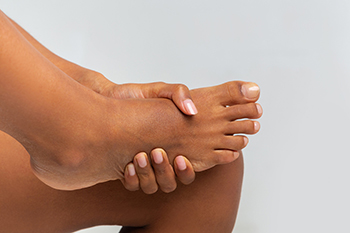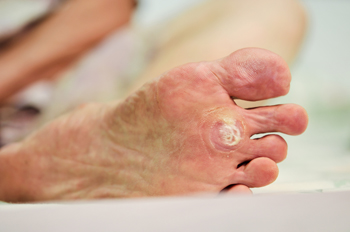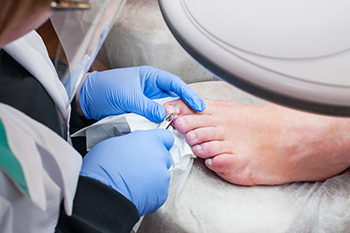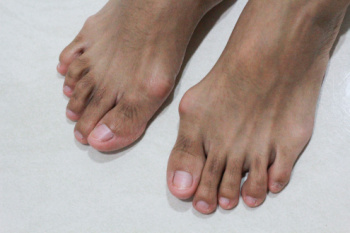Items filtered by date: October 2025
Five Common Foot Problems

Many people experience common foot problems that can cause pain and limit mobility. Bunions are bony bumps that form at the base of the big toe, often due to genetics or wearing poorly fitting shoes, and can cause swelling and discomfort. Fallen arches, or flat feet, can lead to pain in the arch or heel, and may result from aging, injury, or genetics. Hammertoes cause one or more toes to bend abnormally, creating stiffness and difficulty wearing shoes. Ingrown toenails occur when the nail grows into the surrounding skin, leading to redness, swelling, and possible infection. Additionally, plantar fasciitis is a inflammation of the tissue along the bottom of the foot, causing sharp heel pain, especially in the morning. A podiatrist can diagnose these conditions through a thorough exam and imaging tests when needed. Treatment options include custom orthotics, footwear changes, medications, or minor procedures. It is suggested that you schedule an appointment with a podiatrist for proper care and relief.
Foot Pain
Foot pain can be extremely painful and debilitating. If you have a foot pain, consult with Donovan Gowdie, DPM from The Foot & Ankle Treatment Center. Our doctor will assess your condition and provide you with quality foot and ankle treatment.
Causes
Foot pain is a very broad condition that could be caused by one or more ailments. The most common include:
- Bunions
- Hammertoes
- Plantar Fasciitis
- Bone Spurs
- Corns
- Tarsal Tunnel Syndrome
- Ingrown Toenails
- Arthritis (such as Gout, Rheumatoid, and Osteoarthritis)
- Flat Feet
- Injury (from stress fractures, broken toe, foot, ankle, Achilles tendon ruptures, and sprains)
- And more
Diagnosis
To figure out the cause of foot pain, podiatrists utilize several different methods. This can range from simple visual inspections and sensation tests to X-rays and MRI scans. Prior medical history, family medical history, and any recent physical traumatic events will all be taken into consideration for a proper diagnosis.
Treatment
Treatment depends upon the cause of the foot pain. Whether it is resting, staying off the foot, or having surgery; podiatrists have a number of treatment options available for foot pain.
If you have any questions, please feel free to contact our office located in Watkinsville, GA . We offer the newest diagnostic and treatment technologies for all your foot care needs.
Stepping Past the Pain of Plantar Warts

Plantar warts are small, thickened growths that develop on the bottom of the feet due to the human papillomavirus, or HPV. They often appear on weight-bearing areas such as the heel or ball of the foot, causing discomfort or pain when walking. These warts may look like calluses, but often have tiny black dots, which are clotted blood vessels. Because the virus thrives in warm, moist environments, it is commonly contracted in places like locker rooms or public showers. Treatment options include topical medications, cryotherapy, or freezing, laser therapy, or minor procedures to remove the wart. Avoiding walking barefoot in public areas and keeping feet dry can help prevent recurrence. Since plantar warts can spread or become resistant to over-the-counter remedies, it is suggested you see a podiatrist for a proper diagnosis and effective treatment.
Plantar warts can be very uncomfortable. If you need your feet checked, contact Donovan Gowdie, DPM from The Foot & Ankle Treatment Center. Our doctor will assist you with all of your foot and ankle needs.
About Plantar Warts
Plantar warts are the result of HPV, or human papillomavirus, getting into open wounds on the feet. They are mostly found on the heels or balls of the feet.
While plantar warts are generally harmless, those experiencing excessive pain or those suffering from diabetes or a compromised immune system require immediate medical care. Plantar warts are easily diagnosed, usually through scraping off a bit of rough skin or by getting a biopsy.
Symptoms
- Lesions on the bottom of your feet, usually rough and grainy
- Hard or thick callused spots
- Wart seeds, which are small clotted blood vessels that look like little black spots
- Pain, discomfort, or tenderness of your feet when walking or standing
Treatment
- Freezing
- Electric tool removal
- Laser Treatment
- Topical Creams (prescription only)
- Over-the-counter medications
To help prevent developing plantar warts, avoid walking barefoot over abrasive surfaces that can cause cuts or wounds for HPV to get into. Avoiding direct contact with other warts, as well as not picking or rubbing existing warts, can help prevent the further spread of plantar warts. However, if you think you have developed plantar warts, speak to your podiatrist. He or she can diagnose the warts on your feet and recommend the appropriate treatment options.
If you have any questions, please feel free to contact our office located in Watkinsville, GA . We offer the newest diagnostic and treatment technologies for all your foot care needs.
Treatment for Stubborn Ingrown Toenails

Ingrown toenails often linger when the nail continues to press into the skin at the side of the toe, usually affecting the big toe. This pressure can cause pain, swelling, and in more severe cases, infection. While mild cases may improve on their own, stubborn ingrown toenails often need professional care. A podiatrist can relieve discomfort by carefully trimming or removing part of the affected nail. When the condition returns repeatedly, surgery may be recommended to take away part or all of the toenail. Sometimes the root of the nail is removed to prevent it from growing back. These procedures are performed under local anesthetic and can significantly reduce the chance of recurrence. Healing may take several weeks, but most people find that symptoms improve soon after treatment. Prompt care is important to avoid infection and further complications. If you are experiencing the pain of an ingrown toenail, it is suggested that you make an appointment with a podiatrist for an exam and treatment.
Ingrown toenails can become painful if they are not treated properly. For more information about ingrown toenails, contact Donovan Gowdie, DPM of The Foot & Ankle Treatment Center. Our doctor can provide the care you need to keep you pain-free and on your feet.
Ingrown Toenails
Ingrown toenails occur when a toenail grows sideways into the bed of the nail, causing pain, swelling, and possibly infection.
Causes
- Bacterial infections
- Improper nail cutting such as cutting it too short or not straight across
- Trauma to the toe, such as stubbing, which causes the nail to grow back irregularly
- Ill-fitting shoes that bunch the toes too close together
- Genetic predisposition
Prevention
Because ingrown toenails are not something found outside of shoe-wearing cultures, going barefoot as often as possible will decrease the likeliness of developing ingrown toenails. Wearing proper fitting shoes and using proper cutting techniques will also help decrease your risk of developing ingrown toenails.
Treatment
Ingrown toenails are a very treatable foot condition. In minor cases, soaking the affected area in salt or antibacterial soaps will not only help with the ingrown nail itself, but also help prevent any infections from occurring. In more severe cases, surgery is an option. In either case, speaking to your podiatrist about this condition will help you get a better understanding of specific treatment options that are right for you.
If you have any questions, please feel free to contact our office located in Watkinsville, GA . We offer the newest diagnostic and treatment technologies for all your foot care needs.
Understanding Bunions and Their Causes

Bunions are bony bumps that form at the base of the big toe when the joint shifts out of alignment. They can be caused by a variety of factors, including genetics, wearing tight or narrow shoes, and arthritis. Other factors are foot injuries or abnormal foot mechanics, such as flat feet or overpronation. Symptoms include a visible bump on the side of the foot, redness, swelling, pain, and difficulty finding in comfortable footwear. The affected area may feel tender or stiff, and walking can become increasingly uncomfortable as the bunion worsens. A podiatrist can diagnose bunions through a physical examination and imaging tests like X-rays to assess the severity of the deformity. Treatment options range from conservative measures, such as padding, orthotics, and shoe modifications, to minimally invasive or traditional surgery, in more severe cases. Early care can help reduce pain and prevent progression. If you have the beginning signs of a bunion, it is suggested that you schedule an appointment with a podiatrist to discuss symptoms and develop an effective treatment plan.
If you are suffering from bunions, contact Donovan Gowdie, DPM of The Foot & Ankle Treatment Center. Our doctor can provide the care you need to keep you pain-free and on your feet.
What Is a Bunion?
A bunion is formed of swollen tissue or an enlargement of boney growth, usually located at the base joint of the toe that connects to the foot. The swelling occurs due to the bones in the big toe shifting inward, which impacts the other toes of the foot. This causes the area around the base of the big toe to become inflamed and painful.
Why Do Bunions Form?
Genetics – Susceptibility to bunions are often hereditary
Stress on the feet – Poorly fitted and uncomfortable footwear that places stress on feet, such as heels, can worsen existing bunions
How Are Bunions Diagnosed?
Doctors often perform two tests – blood tests and x-rays – when trying to diagnose bunions, especially in the early stages of development. Blood tests help determine if the foot pain is being caused by something else, such as arthritis, while x-rays provide a clear picture of your bone structure to your doctor.
How Are Bunions Treated?
- Refrain from wearing heels or similar shoes that cause discomfort
- Select wider shoes that can provide more comfort and reduce pain
- Anti-inflammatory and pain management drugs
- Orthotics or foot inserts
- Surgery
If you have any questions, please feel free to contact our office located in Watkinsville, GA . We offer the newest diagnostic and treatment technologies for all your foot care needs.

